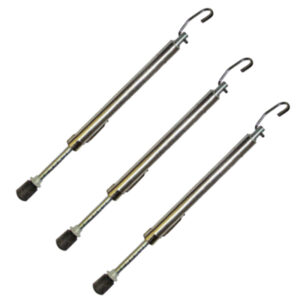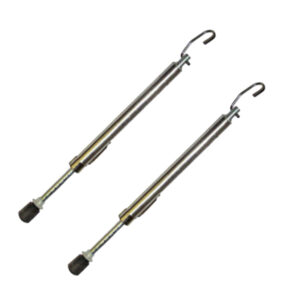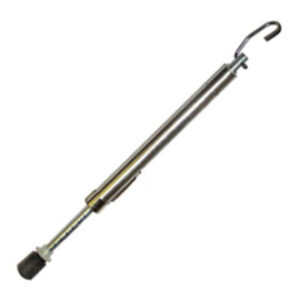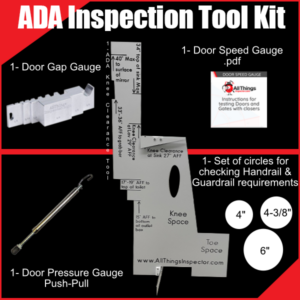Door Pressure Gauge
Precisely Measure Door Pressure to Ensure ADA Compliance, Safety and Functionality

Door Pressure Gauge - Check out our extensive inventory below.
We carry two types of Door Pressure Gauge that show the amount of force (pounds or kg) required to open doors so you can determine if the door meets ADA regulations. An absolutely vital tool if working on doors in facilities requiring full access to disabled persons. It can also be used to determine the amount of force required to open or close elevator doors. The entire Range is from 0 to 35 lbs. (0 to 15.9 kg).
Doors present some of the most common accessibility issues. They may be too “heavy” and require too much force to open. Heavy doors are especially difficult for people with disabilities and seniors with limited upper body strength and/or skills in using their hands. They may close too quickly for some people to pass through easily. People who move slowly or use mobility devices like wheelchairs or walkers may not be able to pass through fast enough. Fortunately, these common problems can often be resolved by simply adjusting door closers. In that case, considering door movement speed is important. Follow these steps to make sure your doors are accessible to all.
What if my business is tax exempt?
- Sale!

Door Pressure Gauge Push-Pull, 0-35 lbs 3 Pack
$164.97Original price was: $164.97.$154.99Current price is: $154.99. Add to cart - Sale!

Push Pull Door Gauge 2 pack, 0-35lbs
$109.98Original price was: $109.98.$103.99Current price is: $103.99. Add to cart -

ADA Door Pressure Gauge Push-Pull, 0-35lbs
$59.99 Add to cart
Measure Door Opening Force and Closing Speed with a Door Force Gauge
The best way to measure door-opening force is by using a door force gauge, also called a door pressure gauge. To do this, first, unlatch the door and then press slowly, the gauge against the door.
Holding the instrument firmly, push until the door opens all the way. The readout on the gauge shows you the force required to open the door. Some gauges have hooks to help you pull the door open. Door force gauges are available online and in some specialty hardware stores.
You may also use a simple mechanical plunger scale or digital fish scale. These options may be less accurate since you have to read the scale while opening the door. To use a fish scale, attach a string to the scale and the door opening hardware.
Measure the maximum force required to pull the door open. Part of properly using a door pressure gauge is knowing how to interpret the measurements against the defined desired force standards and recommended pressure variability allowances.
Interior hinged doors should require no more than 5 lbs. of force to open
This does not apply to the initial force needed to overcome the weight of a motionless door. Open the door gradually; do not “jerk” it open. Opening force for exterior doors is not specified in the ADA Standards, but exterior doors that need to be accessible should have the minimum force possible. The typical maximum opening force for exterior doors ranges from 8.5 to 10 lbs.
Any door so heavy that it prevents entrance by people with disabilities may deny them access to goods and services, which is covered under the ADA.
Also, state or local government codes may have specific accessibility requirements for exterior doors. The closing or swing speed must not be faster than five seconds. The closing or swing distance is from the open position at 90 degrees to 12 degrees from the latch. Latching speed isn’t specified but should be fast enough to latch the door but not slam it. If you need to learn more about door opening forces Up Codes has additional information.

Why Measuring Door Pressure is Important?
Ensuring ADA Compliance for Equal Access: The American Disabilities Act (ADA) sets legal standards for maximum door pressure to enable equal access for all people, regardless of age or physical ability. Measuring door pressure is critical for confirming compliance to ADA guidelines and providing safe, accessible entryways.
Reduce Injury Risks from Doors that Slam or Close Too Forcefully: Doors that close with too much pressure can pose safety hazards and lead to injuries such as bruises, finger pinches, or worse. Properly adjusting door closer pressure prevents doors from slamming or closing too forcibly, creating a safer environment for people passing through.
Prevent Property Damage from Excessive Force: Doors (especially sliding and folding doors) that consistently close with excessive pressure can also cause property damage over time. The constant force can loosen door’s hinges, cause doors/frames to crack or split, and wear down seals and weather stripping. Measuring pressure enables proper adjustments before deterioration or costly repairs are needed.
Verify Door Closers Function Properly Through Their Swing Cycle: As door closer devices wear down with use over time, the amount of pressure they exert often fluctuates inconsistently through the door’s full swing cycle. Checking pressure at different points tests that closers function properly and provide uniform force as needed for safety.
Identify and Troubleshoot Issues with Seals, Hinges, Automatic Openers, etc: Improper door pressure can also indicate problems with door components like broken seals, loose doors hinges, incorrectly calibrated automatic power assisted door openers, and more. Identifying pressure inconsistencies helps inspectors troubleshoot issues and determine necessary repairs or replacements. Regular pressure checks validate full door assembly functionality.
Push Gauges
ADA Push Door Pressure Gauge
According to the ADA, doors present some of the most common accessibility concerns for disabled persons. Doors that require too much force to open create difficulties for the elderly, for the disabled, and for anyone without sufficient upper-body strength. The ADA compliance limit gauges door closure pressure while stationary, inspectors should also validate acceptable rolling force ranges during active door movement to cover all bases. Excess variability can still constitute a safety hazard.
Door Gauges
Whether you need a Door Gap Gauge to inspect a fire rated door or a push pull gauge to check a fire rated or non fire rated door for what the disabilities act requires, we have the tools you need.
Operating Instructions For Testing Doors And Gates With Closers
We do have a page dedicated just to learn more about our door gap gauge and a couple of door gap gauge instructional videos for your viewing pleasure.
Some of our Previous Clients Include





Door Gap Gauge - See our extensive inventory
- Sale!

Inspection Tool Kit
$349.00Original price was: $349.00.$299.99Current price is: $299.99. Add to cart - Sale!

Door Inspection Tool Kit
$94.93Original price was: $94.93.$89.99Current price is: $89.99. Add to cart -

Door Gap Gauge 6 Pack + Cup
$204.64 Read more - Sale!

Door Gap Gauge 6 Pack
$169.99Original price was: $169.99.$144.49Current price is: $144.49. Add to cart -

Door Gap Gauge 5 Pack
$149.75 Add to cart -

Door Gap Gauge 4 Pack
$119.00 Add to cart -

Door Gap Gauge 3 Pack
$89.85 Add to cart

